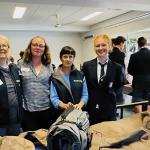ShelterBox support for Myanmar
PICTURED: People clear debris off a damaged Buddha statue at Lawkatharaphu pagoda in Inwa on the outskirts of Mandalay following the devastating March 28 earthquake. (Photo: Sai Aung MAIN/AFP)
Following the 7.7 magnitude earthquake that struck Myanmar on March 28, ShelterBox Australia is battling complicated conditions to get aid to where it is needed most.
The 7.7 magnitude earthquake that devastated Myanmar in March was the largest to strike the country since 1912, forcing up to one million people from their homes. Two weeks later, another significant earthquake (5.5M) struck central Myanmar on Sunday, April 13.
Today, people are still living and sleeping outside because their homes have collapsed or because they fear going back inside. Others are living in damaged buildings, which may not be safe. In the worst-hit area of Sagaing, a third of all houses have collapsed.
The earthquake was so powerful it buckled roads, destroyed schools and hospitals, and had a significant impact on water supplies and power lines.
People are without shelter, clean water, food and medical care. The hardest-hit areas remain without electricity and water. Communications are severely disrupted, and people are cut off from vital services. There is a huge amount of uncertainty.
Aid has started to arrive, but it’s not enough. People need urgent access to clean water, food, shelter, medicine and protection from diseases. Pre-existing issues, such as conflict in places like Myanmar, can make responding to an earthquake much more challenging. Myanmar is in the grip of an intense civil war and access is limited, so the true scale of destruction is only just emerging.
The earthquake exposed and shifted unexploded ordnance, significantly increasing the risks for affected communities as well as those looking to support them.
On top of that, heavy rains have lashed parts of the country, complicating relief efforts and increasing the risk of disease.
The response from Rotary in Australia has been swift and generous. ShelterBox is working night and day to get aid to people in Myanmar.
Working somewhere that has suffered a disaster but is also in the middle of an active conflict increases the insecurity of the affected community and potentially the humanitarian response,” says Ian Neal, a ShelterBox response team member in Yangon. “Responding to such complex crises, we have to plan every move and every decision to ensure we do no harm to the community, our partners or team.
“Coordination and collaboration are vital in the aftermath of any disaster. Being in Yangon, we have been able to have face-to-face meetings with local, national and international organisations, which has been invaluable in developing our understanding of this complex situation and the needs of the affected population.
“It’s allowing us to work out where we can add value and how to support the response effort in the most effective way, so that people get the shelter and support they need.”
Marie Sach, another ShelterBox response team member in Yangon, agrees.
There is huge value in being closer to people affected and the organisations that work to support those who have been affected by years of conflict and multiple disasters.
“The types of homes that have been destroyed by the earthquake vary hugely because the areas affected include very dry areas and areas affected by flooding and so one solution will not suit all communities.
“We are looking at hard-to-reach areas that, from experience, are often the most under-served communities. We will continue to work with partners to identify the most appropriate aid packages, understanding what affected communities need most.”
How can you help?
-
Donate to the ShelterBox Myanmar earthquake appeal (shelterboxaustralia.org.au)
-
Share ShelterBox Australia’s social posts
-
Organise a fundraiser
Related news
#OffTheGrid 2025
Braving winter wind and rain, Rotary clubs camped out for 24 hours to raise $14,000 for ShelterBox’s #OffTheGrid.
ShelterBox celebrates 25 years of emergency shelter
Celebrating 25 years of ShelterBox and Rotary: helping more than three million people rebuild after disaster.
Join our newsletter for the latest updates
"*" indicates required fields


